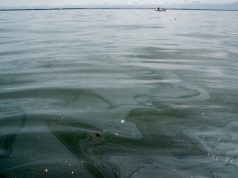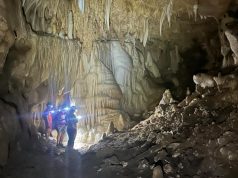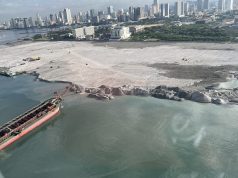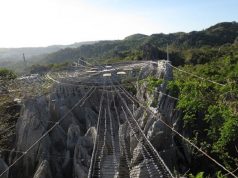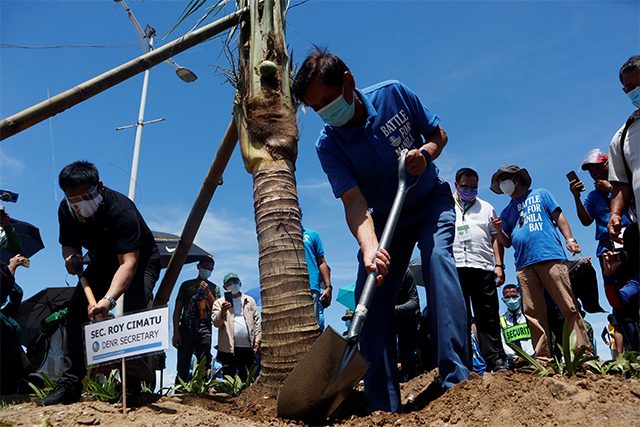
The Department of Environment and Natural Resources (DENR) on Wednesday expanded the Manila Bay rehabilitation project beyond pouring over controversial white sand.
The department planted coconut palms along Baywalk on Roxas Boulevard. It said the initiative is part of its “continuing activities and efforts for the clean-up and rehabilitation of Manila Bay.”
LOOK: Environment Secretary Roy A. Cimatu in the ceremonial planting of coconut palms along Roxas Boulevard as part of the beautification and restoration of the Manila Baywalk.#TayoAngKalikasan#BattleForManilaBay #SaveManilaBay pic.twitter.com/gKH9HCuXwV
— DENR (@DENROfficial) June 16, 2021
Since last year, the white sand beach project has stirred controversy due to perceived misplaced priorities while the country was still battling the COVID-19 pandemic.
People flock to Manila Bay’s ‘white sand beach’ along Roxas Boulevard on Sunday morning to demonstrate the viability of using crushed dolomite in rehabilitating & beautifying Manila Bay.
At the expense of public safety & COVID social distancing protocol🤦pic.twitter.com/BPTsTTVEJM
— Zaldy Tor (@zaldytor) September 20, 2020
The DENR’s budget for the 2019 Manila Bay rehabilitation program costs around P389 million. P28 million of the budget was spent for the dolomite sand project.
Critics have said the money used for Manila Bay beautification could have been funneled to the national government’s funds for vaccine supplies, social amelioration for poor families and distance learning needs.
READ: Vaccine over sand: Fresh dose of dolomite in Manila Bay draws renewed criticisms
The government, however, tried to justify the white sand makeover, saying it was meant to prevent people from dumping garbage in the area.
Malacañang, moreover, said the dolomite project could improve Filipinos’ mental health as they tried to adjust to the pandemic.
Plant mangroves
While the DENR envisions Manila Bay as a tropical paradise, coastal communities have called for the restoration of its marine and fishery resources.
“Still absurd, trying hard, waste of public resources, and simply for aesthetics with a meager to no contribution to the rehabilitation of Manila Bay,” Pambansang Lakas ng Kilusang Mamamalakaya ng Pilipinas (Pamalakaya) tweeted.
READ: DENR must restore mangroves, seagrasses in Manila Bay instead of planting coconut trees — fishers
The budget for the dolomite sand project is more than enough to install mangrove forests in Manila Bay, the group said.
Mangrove planting costs at least $607.7 or P28, 881.6 per hectare (Primera and Esteban, 2008), which means that the DENR's whopping P389 for Manila Bay "beautification" through "white sand" filling could plant a total of 13, 469 hectares of mangrove forests! pic.twitter.com/1s0fB0Jzjn
— Pamalakaya Pilipinas (@pama_pil) September 4, 2020
Instead of planting coconut trees and dumping dolomite, Filipinos on social media also urged the environment department to restore mangroves, which can serve as a fish sanctuary, pollution filters and coastal defense against strong waves and storm surges.
Storm surges are high waves of sea water that are going inland due to Typhoons like #RollyPH.
But do you know that our nature can protect us as well from Storm Surges?
Nope, not the Dolomite Sand, but the Mangroves.
Imagine if instead of SAND they planted MANGROVES. 🤔 pic.twitter.com/U65mzCtvvF
— The Portraits MNL (@ThePortraitsMNL) November 1, 2020
“Personally, I like my Manila Bay trash-free, with lots of storm surge resistant plants and trash cans. Bonus na if someone will put up a mangrove sanctuary somewhere in the area. No need for fake white sand to make it beautiful. You made it look cheap TBH,” a Twitter user said in 2020.
Some Twitter users also poked fun at the Manila Bay makeover.
“Paano naging rehabilitation to @DENROfficial? Eh yung mga coconut hindi naman tinanim sa mismong beach kundi sa lupang napapalibutan ng semento. Kung rehabilitation ito, ano ang positive ecological effect nito? #SaveManilaBay This is purely aesthetics, and not rehabilitation!,” a Twitter user said.
In May 2021, the DENR allotted a P265 million budget for the second phase of the Manila Bay “Beach Nourishment Project” to be implemented by the Department of Public Works and Highways (DPWH).
This requires dredging of garbage and silt and dumping of filling materials. The first phase involved the overlaying of crushed dolomite at a 500-meter stretch of the Manila Baywalk.
However, Environment Undersecretary for Policy Planning and International Affairs Jonas Leones last May was quoted as saying that there is “still no Memorandum of Agreement yet for the project” and that the funds have yet to be transferred from DENR to DPWH.
Based on DENR’s website, the project has three phases: cleanup and water quality improvement, rehabilitation and resettlement, and education and sustainment.
The DENR is currently fast-tracking the clean-up and beautification of Manila Bay project. It is eyeing to reopen the white-sand beach to the public in July.





